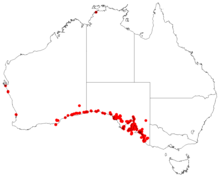| Amyema melaleucae | |
|---|---|

| |
| Scientific classification | |
| Kingdom: | Plantae |
| Clade: | Tracheophytes |
| Clade: | Angiosperms |
| Clade: | Eudicots |
| Order: | Santalales |
| Family: | Loranthaceae |
| Genus: | Amyema |
| Species: | A. melaleucae |
| Binomial name | |
| Amyema melaleucae (Lehm. ex Miq.) Tiegh. | |

| |
| Collections data from the Australasian Virtual Herbarium | |
| Synonyms | |
Amyema melaleucae, also known as the tea-tree mistletoe, is a species of flowering plant within the genus Amyema, an epiphytic hemiparasitic plant of the family Loranthaceae native to Australia and found in Western Australia and South Australia on the coast, from north of Perth almost to the Victorian border.
Description
It is an erect shrub with a single haustorium. The leaves are narrow and lanceolate (20 to 45 mm long and from 2 to 4 (sometimes) 7 mm wide) with no petiole, and rounded at the apex. Unlike many other Amyemas, the corolla in bud is smooth. The inflorescence consists of an umbel of triads (flowers in groups of three) on a stalk (peduncle). The central flower is without a stem (pedicel), while the lateral flowers are on angular pedicels. The corolla is club-shaped. The flowers are pink and red and may be seen from January to April or August to November. The fruit is almost globular.
Ecology
It grows in coastal scrub, (usually) on Melaleucas., Barlow (1984) and Paczkowska (1995) both state that is only found on Melaleucas. However, an extensive examination of herbaria records by Downey (1998) showed that it has been found on Casuarina species, Myoporum species, Exocarpos species and Pittosporum species, as well as Melaleuca cardiophylla, M. halmaturorum, M. lanceolata, M. parviflora, M. pauperiflora, Melaleuca pubescens (=M. lanceolata), M. quadrifaria and M. thyoides.
Taxonomy
It was first described by Miquel in 1845 as Loranthus melaleucae, who described it from a specimen found growing on a Melaleuca on Rottnest Island. In 1895 it was placed in the genus Amyema by Tieghem.
References
- ^ "'Australian Plant Name Index (APNI): Amyema melaleucae, IBIS database. Centre for Plant Biodiversity Research, Australian Government". Retrieved 14 May 2018.
- ^ M. Ph. Van Tieghem (January 1895). "Sur Les Loranthoidées D'Australie". Bulletin de la Société Botanique de France. 42 (2): 82, 84. doi:10.1080/00378941.1895.10830580. ISSN 0037-8941. Wikidata Q54801402.
- Govaerts, R. et.al. 2018. "Plants of the World online: Amyema melaleucae (synonyms)". Board of Trustees of the Royal Botanic Gardens, Kew. Retrieved 14 May 2018.
- "AVH: Amyema melaleucae (mapview), Australasian Virtual Herbarium". Retrieved 10 May 2018.
- ^ "FloraBase: Ameyma melaleucae, Western Australian Herbarium, Biodiversity and Conservation Science, Department of Biodiversity, Conservation and Attractions". Retrieved 14 May 2018.
- ^ "Electronic Flora of South Australia species Fact Sheet Amyema melaleucae". Government of South Australia, Department of Environment, Water and Natural Resources. Retrieved 14 May 2018.
- ^ Barlow, B.A. 1984. "Flora of Australia Online: Amyema melaleucae, Data derived from Flora of Australia Volume 22, a product of ABRS, ©Commonwealth of Australia". Archived from the original on 15 May 2018. Retrieved 14 May 2018.
- ^ Barlow, B.A. 1984. "Flora of Australia Online: key to Amyema, Data derived from Flora of Australia Volume 22, a product of ABRS, ©Commonwealth of Australia". Archived from the original on 9 May 2018. Retrieved 14 May 2018.
- Paul Owen Downey (1998). "An inventory of host species for each aerial mistletoe species (Loranthaceae and Viscaceae) in Australia" (PDF). Cunninghamia. 5 (3): 685–720. ISSN 0727-9620. Wikidata Q106567982.
- Miquel, F.A.W. 1845. in Lehmann, J.G.C. (ed.), Loranthaceae. Plantae Preissianae 1(2): 281
| Taxon identifiers | |
|---|---|
| Amyema melaleucae | |